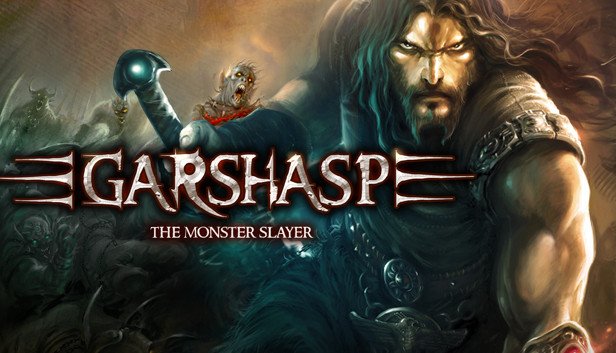Garshasp is a game that is clearly a product of its time. It’s a mediocre hack and slash, but also an unoriginal one. The gameplay is clearly pulled from a couple notable franchises, while the story is generic heroic filler. Still, it manages to stand out for both good and bad reasons.
The presentation of Garshasp is it’s most original aspect. While much of the level design is derivative, the visual design of the world is unique. The game was developed in Iran and loosely inspired by Persian mythology, so a fair amount of the visuals pull from this setting. Unfortunately, the graphics look dated, even for a game from 2011. Textures are blurry and the facial model of the protagonist is hideous. The pre-rendered cut scenes have more polished animations than the game, but only look marginally better when it comes to graphics.
Sound design in Grashasp is poorly implemented, with some awful mixing during narration. Voice actors are almost impossible to understand because their voices are quieter than the background music. On the rare occasion that the voices are loud enough to be heard, they are smothered with distortion effects to the point of incomprehensibility. During combat, the protagonist has 2-3 grunts/yells that are replayed over and over. It quickly becomes annoying, especially when you realize that different combos use the same voice line, so you can’t even use the repetitiveness to help understand what is going on in combat. The soundtrack isn’t as terrible as the rest of the audio, although it’s still underwhelming. For a game like this, it does the job well enough to not be noticeable.
The biggest issue that Garshasp has is its gameplay. It is broken up into a few categories. There are combat sections, platforming sections, and wall sliding sections. Somewhat surprisingly, none of them stand out as the obvious best or worst system, they are all pretty equal in quality. Unfortunately, this hurts the game’s potential niche appeal. Many flawed games tend to be hit or miss, with some great mechanics and some terrible ones. A game with an awful story might have fun gameplay, making it unappealing to a fan of storytelling, but perfect for someone that enjoys mindless action. For Garshasp, everything is mediocre. Nothing about it is a deal breaker, but nothing makes you want to play it. It is simply a worse version of games that already exist.
Combat in Garshasp is modeled after God of War, but it feels like a hollow shell. It plays like someone loved God of War and tried to recreate it by sight. There are many similar elements, but it is only skin deep. Combos are boring, with the most advanced combo being 2 left clicks and 1 right click. It also uses an orb system, similar to God of War, complete with animations that mirror the ones from opening a chest in GoW. Boss fights play out like normal combat, but with a quicktime event at the end. This also begins to bleed over into combat with standard enemies, as some of the later ones start requiring quicktime events to kill. Overall, it feels like the developers knew GoW was fun, but either didn’t know how to recreate it, or didn’t have the budget to.
The platforming sections of the game could have been an interesting way for the game to set itself apart from GoW, but instead it feels generic and halfhearted. It has climbing sections reminiscent of Assassin’s Creed, but the controls are abysmal. There isn’t a way to control the camera, so it either snaps to a new angle or rotates at will, making it difficult to go where you want to. The camera issues mildly affect combat, but they make the platforming sections the hardest part of the game. The controls don’t adapt to the new angle, so it is easy to find yourself running to the right of the screen, then quickly change to running towards the bottom on accident. The level design for this portion of the game is lackluster and overly lengthy. There are large portions of walking in a straight line, with no obstacles or hazards in sight. Elevators take 30 seconds to arrive at their destination, for seemingly no reason. Everything about this part of the game feels like a time waster.
The final piece of gameplay is the wall sliding system. There are only a few of them in the game, but certain walls will require you to stab your knife into the wall and slide down it. You can change your speed and direction, allowing you to try and avoid hazards. It feels like a mini-game that got too much screen time. It takes a while to finish and falling is an instant death that requires you to restart from the beginning. It is more frustrating than fun and adds little to the experience.
While Garshasp is attempting to be a mindless hack and slash, it still has some story to it. It is difficult to hear most of it, so I was stuck guessing what was going on, but from what I could gather, it’s a bland “bad guy stole something, hero gets it back” plot line. You see the main villain in the beginning of the game, he steals a mace, you track him down and take it back. There is no real character development, and I’m pretty sure the protagonist is silent until he says 2 lines during the final boss fight. This is probably the sparsest part of the game, although the developers didn’t try to make this a story-based game, so it’s understandable.
Garshasp is a severely flawed game, but I still admire the ambition of the developers. They were an indie studio trying to compete with a AAA franchise, and they went for it. It clearly didn’t work out how they wanted, but they put in a lot of effort. Some of the big set pieces were great, while the Persian influence was a unique element that they utilized quite well. There were a handful of performance issues and bugs, but for the most part, the game held up decently in terms of programming. It’s a perfect example of a game with plenty of unrealized potential that was plagued by poor execution.




